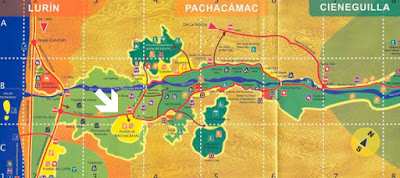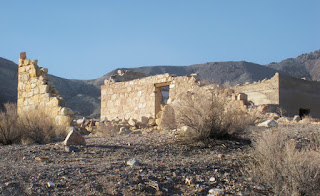In 1903, Max Uhle, published writings on the ancient ruin outside Lima called Pachacamac, in the University of Pennsylvania Publications Folio, Philadelphia, in which he wrote:
“Pachacamac, which means “Creator God,” was a famous religious center in ancient Peru, comparable to the Egyptian Thebes or the Mohammedan Mecca. According to Estes, it originally contained a shrine of the "creator " god, Pachacamac, to which flocked pilgrims coming from all parts of Peru, three hundred leagues or more,” and later, after conquest of the place by the Peruvians of the highlands, it also had a famous Temple of the Sun.
Situated about 20-miles southeast of the Lima city center, the archaeological complex of Pachacamac is a pre-Columbian citadel made up of numerous adobe and stone palaces and temple pyramids
But Pachacamac was more than a religious center that drew pilgrimages, it was at the same time, as Uhle added, “a political center, the seat of a leader who ruled over the populous valleys of Lurin, Rimac, Chancay, Huacho, Supe, and Huanan, according to Garcilasso, with Its decline dating from the year of the entrance of the Spaniards in 1533 and the destruction by them of the venerated statue of the principal deity.
This sounds very much like the governing of Zarahemla, where it would have been the governing body of the entire Land of Zarahemla, which included a swath of land from the West Sea to the East Sea and from the narrow strip of wilderness in the south to almost the Bountiful border in the north, and would have been seen as the seat of the national government of the Nephites and controlling at least the entire Land Southward north of the lands of Nephi and Lehi.
In the early fifties of the sixteenth century the Augustinian monks transferred the town to the valley.” According to Fray Antonio de la Calancha, by the seventeenth century Pachacamac was already a desolate pile of ruins, forgotten, and no longer a center of anything.
Julio C. Tello, the famed Peruvian archaeologist and considered the “father of Peruvian archaeology,” with his team that conducted several excavations of Pachacamac between 1940 and 1941
According to Donald A. Prouix, Professor of Anthropology Emeritus, University of Massachusetts, Amherst, who said “Self-billed as a mountain Indian, Julio César Tello was arguably the greatest Native American social scientist of the twentieth century. Because he overcame obscure origins, secured an unprecedented education, and rose to national and international prominence, his life is an inspiring story with broad appeal. Tello’s embrace of anthropology and archaeology provides an enlightening contrast to current conditions in much of the New World, and thus his views have considerable contemporary resonance.”
Unlike the archaeologists who flock to Mesoamerica, Julio Tello was the most distinguished Native American scholar ever to focus on archaeology. A Quechua speaker born in a small highland village in 1880, Tello did the impossible: he received a medical degree and convinced the Peruvian government to send him to Harvard and European universities to master archaeology and anthropology. He then returned home to shape modern Peruvian archaeology and the institutions through which it was carried out. His work at Pachacamac and elsewhere were the first stratigraphic excavations in Peru, which was part of the era of “real” archaeology in the minds of modern archaeologists.
The front of Pachácamac where it overlooks the ocean over which the Mulekites sailed, and the beach where they would have landed
“The majesty of the Pachacamac palaces, temples, plazas, and
the high truncated pyramid convey to us the political, cultural, and religious
hierarchy of ancient Pachacámac. In the pre-Inca and Inca periods, it was the
most important oracle of the Peruvian coast, where thousands of pilgrims
traveled from the farthest corners of ancient Peru.”The god Pachacámac, indigenous to the central coast, survived the influence of the Incas and the Spanish. According to Inca mythology, he was the god of fire and the child of the sun, rejuvenator of the world—in short, the creator of the world and all the creatures that inhabit it.
According to Timothy K. Earle (Department of Anthropology University of Michigan) the coastal area of the Lurin Valley was first settled around to 200 B.C. (“Lurin Valley, Peru: Early Intermediate Period Settlement Development,” American Antiquity, Society for American Archaeology, vol 37 No 4, 1972, pp467-477). This is about the same time that Mosiah reached Zarahemla), and stood for centuries. Long before the Incas established themselves along the coast, while the Chavin were settling and building north of Lima, the foreruners of the Wari culture erected the great Ceremonial Center at Pachacámac: numerous temples with ramps, and the Painted Temple are examples of their religious town planning. When they were destroyed, several small kingdoms and confederations (tribes) were created, and over time two cultures came to dominate the region, the Chancay to the north of Lima and the Ichma (Yschma) culture to the south in the Lurin valley, though they later spread north into the Rimac valley as well.
However, it should be noted, and you probably won’t hear this suggested elsewhere, that in the scriptural record, there is no mention of a City of Zarahemla in either the Omni or Mosiah accounts. In fact, in Mosiah, the “land of Zarahemla” is mentioned 22 times, the “people of Zarahemla”is mentioned 5 times and being a “descendant of Zarahemla” is mentioned 2 times—but Zarahemla being a city is never mentioned. Not until Alma 2:25 is Zarahemla referred to as a “city” and called the “city of Zarahemla” (Alma 2:26). From that point onward it is referred to as the “city of Zarahemla” 11 times in Alma, and the “land of Zarahemla” 60 times,which should suggest two things:
1: Most of the events in Alma took place in the surrounding land, not in the city; and
2. The Mulekites may not even have lived in a city when Mosiah I discovered them. No city is mentioned or suggersted at any time until Alma 2:25-6 which is 43 years after their discovery by Mosiah I.
The point is, that while the Lurin Valley was inhabited from 200 B.C., according to discovered archaeological findings, no buildings were constructed until about 400 years later. Assuming Mulek landed around 600 B.C., and Mosiah discovered them 400 years later, around 200 B.C., then the time frame correlates, and obviously would be off a few hundred years from dates since carbon-14 dating is not accurate to that degree as we have pointed out in these pages in numerous articles, as well as in our book Scientific Fallacies & Other Myths.
(See the next post, “Pachacamac: The City of Zarahemla – Part IV,” for more information on where the Mulekites settled and Mosiah found them along the cost near Lima, Peru)




































